

Aharonov–Casher effect. In both effects the particle acquires some phase shift ( ) while traveling along some path P.

Aharonov–Bohm effect. Werner Ehrenberg and Raymond E.

Siday first predicted the effect in 1949,[3] and similar effects were later published by Yakir Aharonov and David Bohm in 1959.[4] After publication of the 1959 paper, Bohm was informed of Ehrenberg and Siday's work, which was acknowledged and credited in Bohm and Aharonov's subsequent 1961 paper.[5][6] Subsequently, the effect was confirmed experimentally by several authors; a general review can be found in Peshkin and Tonomura (1989).[7] Significance[edit] The Aharonov–Bohm effect is important conceptually because it bears on three issues apparent in the recasting of (Maxwell's) classical electromagnetic theory as a gauge theory, which before the advent of quantum mechanics could be argued to be a mathematical reformulation with no physical consequences.
The Aharonov–Bohm thought experiments and their experimental realization imply that the issues were not just philosophical. The three issues are: Popper's experiment. Popper's experiment is an experiment proposed by the philosopher Karl Popper.

As early as 1934 he was suspicious of, and was proposing experiments to test, the Copenhagen interpretation, a popular subjectivist interpretation of quantum mechanics.[1][2] Popper's experiment is a realization of an argument similar in spirit to the thought experiment of Einstein, Podolsky and Rosen (the EPR paradox) although not as well known. There are various interpretations of quantum mechanics that do not agree with each other. Despite their differences, they are experimentally nearly indistinguishable from each other.
The most widely known interpretation of quantum mechanics is the Copenhagen interpretation put forward by Niels Bohr. It says that observations lead to a wavefunction collapse, thereby suggesting the counter-intuitive result that two well separated, non-interacting systems require action-at-a-distance. Quantum eraser experiment. The double-slit quantum eraser experiment described in this article has three stages:[1] First, the experimenter reproduces the interference pattern of Young's double-slit experiment by shining photons at the double-slit interferometer and checking for an interference pattern at the detection screen.Next, the experimenter marks through which slit each photon went, without disturbing its wavefunction, and demonstrates that thereafter the interference pattern is destroyed.

Wheeler's delayed choice experiment. Wheeler's delayed choice experiment is actually several thought experiments in quantum physics, proposed by John Archibald Wheeler, with the most prominent among them appearing in 1978 and 1984.[1] These experiments are attempts to decide whether light somehow "senses" the experimental apparatus in the double-slit experiment it will travel through and adjusts its behavior to fit by assuming the appropriate determinate state for it, or whether light remains in an indeterminate state, neither wave nor particle, and responds to the "questions" asked of it by responding in either a wave-consistent manner or a particle-consistent manner depending on the experimental arrangements that ask these "questions.
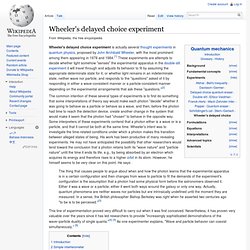
"[2] This line of experimentation proved very difficult to carry out when it was first conceived. Schrödinger's cat. Schrödinger's cat: a cat, a flask of poison, and a radioactive source are placed in a sealed box.
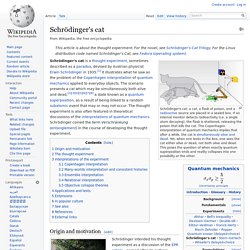
If an internal monitor detects radioactivity (i.e. a single atom decaying), the flask is shattered, releasing the poison that kills the cat. The Copenhagen interpretation of quantum mechanics implies that after a while, the cat is simultaneously alive and dead. Yet, when one looks in the box, one sees the cat either alive or dead, not both alive and dead. This poses the question of when exactly quantum superposition ends and reality collapses into one possibility or the other. Stern–Gerlach experiment. Basic theory and description[edit]
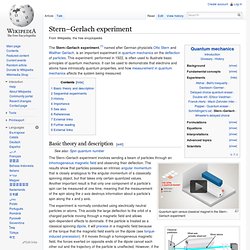
Elitzur–Vaidman bomb tester. Bomb-testing problem diagram.
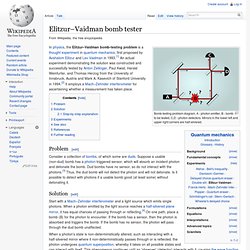
A - photon emitter, B - bomb to be tested, C,D - photon detectors. Mirrors in the lower left and upper right corners are half-silvered. In physics, the Elitzur–Vaidman bomb-testing problem is a thought experiment in quantum mechanics, first proposed by Avshalom Elitzur and Lev Vaidman in 1993.[1] An actual experiment demonstrating the solution was constructed and successfully tested by Anton Zeilinger, Paul Kwiat, Harald Weinfurter, and Thomas Herzog from the University of Innsbruck, Austria and Mark A.
Kasevich of Stanford University in 1994.[2] It employs a Mach–Zehnder interferometer for ascertaining whether a measurement has taken place. Problem[edit] Mach–Zehnder interferometer. Figure 1.
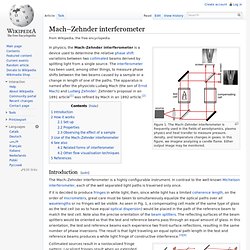
The Mach–Zehnder interferometer is frequently used in the fields of aerodynamics, plasma physics and heat transfer to measure pressure, density, and temperature changes in gases. In this figure, we imagine analyzing a candle flame. Either output image may be monitored. Introduction[edit] Franck–Hertz experiment. Photograph of a vacuum tube with a drop of mercury that's used for the Franck–Hertz experiment in instructional laboratories.

A - anode disk. G - metal mesh grid. C - cathode assembly; the cathode itself is hot, and glows orange. Delayed choice quantum eraser. A delayed choice quantum eraser, first performed by Yoon-Ho Kim, R. Yu, S.P. Kulik, Y.H. Shih and Marlan O. Double-slit experiment. The double-slit experiment is a demonstration that light and matter can display characteristics of both classically defined waves and particles; moreover, it displays the fundamentally probabilistic nature of quantum mechanical phenomena.
The experiment belongs to a general class of "double path" experiments, in which a wave is split into two separate waves that later combine back into a single wave. Changes in the path lengths of both waves result in a phase shift, creating an interference pattern. Another version is the Mach–Zehnder interferometer, which splits the beam with a mirror. This experiment is sometimes referred to as Young's experiment and while there is no doubt that Young's demonstration of optical interference, using sunlight, pinholes and cards, played a vital part in the acceptance of the wave theory of light, there is some question as to whether he ever actually performed a double-slit interference experiment.[1] Overview[edit]
Davisson–Germer experiment. History and Overview[edit] According to Maxwell's equations in the late 19th century, light was thought to consist of waves of electromagnetic fields and matter was thought to consist of localized particles. However, this was challenged in Albert Einstein’s 1905 paper on the photoelectric effect, which described light as discrete and localized quanta of energy (now called photons), which won him the Nobel Prize in Physics in 1921. In 1927 Louis de Broglie presented his thesis concerning the wave-particle duality theory, which proposed the idea that all matter displays the wave-particle duality of photons.[2] According to de Broglie, for all matter and for radiation alike, the energy E of the particle was related to the frequency of its associated wave ν by the Planck relation: And that the momentum of the particle p was related to its wavelength by what is now known as the de Broglie relation: where h is Planck's constant.
Bell test experiments. Bell test experiments or Bell's inequality experiments are designed to demonstrate the real world existence of certain theoretical consequences of the phenomenon of entanglement in quantum mechanics which could not possibly occur according to a classical picture of the world, characterised by the notion of local realism. Under local realism, correlations between outcomes of different measurements performed on separated physical systems have to satisfy certain constraints, called Bell inequalities. Loopholes in Bell test experiments. In Bell test experiments, there may be problems of experimental design or set-up that affect the validity of the experimental findings.
These problems are often referred to as "loopholes". See the article on Bell's theorem for the theoretical background to these experimental efforts (see also J.S. Bell's theorem. Bell's theorem is a no-go theorem famous for drawing an important distinction between quantum mechanics (QM) and the world as described by classical mechanics. EPR paradox. Albert Einstein. Quantum critical point. Quantum phase transition. Classical description[edit] Rabi resonance method. Rabi resonance method is a technique developed by Isidor Isaac Rabi for measuring the nuclear spin. Jaynes–Cummings model. Quantum fluctuation. Rabi cycle. Rabi-Oszillation. Schematische Darstellung eines Zweizustandssystems, das mit elektromagnetischer Strahlung wechselwirkt.
Harmonischer Oszillator (Quantenmechanik) Ein solches quadratisches Potential bezeichnet man auch als harmonisches Potential. Klassisch erhält man dieses Potential für ein System, dessen Rückstellkraft proportional zur Auslenkung aus der Ruhelage ist. Da ein beliebiges Potential in der Nachbarschaft einer stabilen Gleichgewichtslage näherungsweise als harmonisches Potential beschrieben werden kann, ist dies eines der wichtigsten Modellsysteme in der Quantenmechanik. Zudem ist es eines der wenigen quantenmechanischen Systeme, für das eine genaue analytische Lösung bekannt ist. Der Hamilton-Operator, der in der Quantenmechanik die Gesamtenergie (kinetische Energie + potentielle Energie), beschreibt, ist für den harmonischen Oszillator Dabei ist m die Teilchenmasse, ω die Eigenkreisfrequenz des Oszillators, der Ortsoperator,
Schubnikow-de-Haas-Effekt. 3D (VRML) Fermi Surface Database.